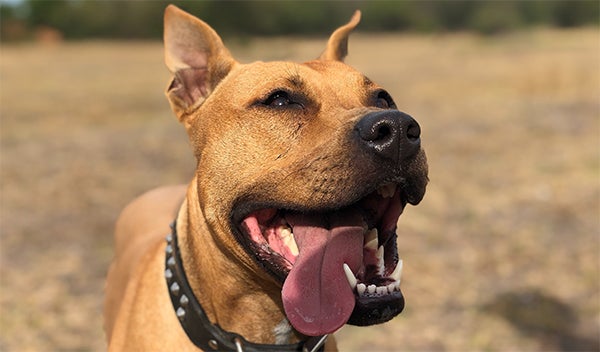October 10, 2018
7 Lesser Known Pitbull Facts
October is not only National Pit bull Awareness Month, but October 28 is also National Pit bull Awareness Day. To celebrate, we are sharing some lesser-known facts about pit bulls in the hopes everyone will see pit bulls for what they are—normal, loving, animals.
1. The Label “Pit bull” Usually Refers to a Cross Breed

Dogs recognized as pit bulls are actually a cross breed of bulldogs and terriers. There are five combinations of breeds that typically get labeled as pit bulls. Those are:
- American bulldogs
- American pit bull terrier
- American Staffordshire terriers
- Staffordshire bull terrier
- English bull terrier
2. Pit bulls’ Lineage Traces Back to England in the 1600s
Pit bulls descend from bulldogs. Bulldogs were used as early as the 1600s for bull and bear baiting (their name descends from their use as bull baiters). In the mid-1800s, some very observant people determined such blood sports were very cruel and made bull baiting illegal. For those who this decision was less obviously a very good one replaced bull baiting with dog fighting. To make it more entertaining, they crossbred bulldogs with terriers. The result was the animal that we know and love today.
3. Pit bulls Held a Lot of Value to Early American Immigrants
Pit bulls made their way to America on ships alongside immigrants looking for a new lease on life. Of course, early America was a tad more rustic than it is now, and survival was often a daily struggle. Because of their protective attributes, pit bulls were considered very valuable.
- They helped their owners by protecting them.
- They also defended livestock from predators and intruders.
- They abetted hunts by acting as hog catchers.
- Lastly, they served as companions to young children, which is the start of how they evolved into family pets.
So, without pit bulls, some early American families and communities may have suffered for lack of food or protection.
4. Pit bulls Make Great Family Pets

Throughout the years, pit bulls continued to be great family pets. Despite the negative news that sometimes surrounds the typically muscular, square-headed dogs, pit bulls were ranked as the second most tolerant dogs in a test by the American Temperament Test Society, Inc., American Humane Association, ASPCA. The results were originally shared by The Huffington Post.
The results also showed that in the overwhelming majority of cases where pit bulls were associated with attacks on people or other animals, the dog had been neglected or abused. Conditions where dogs are trained to be aggressive or are not trained to socialize are also circumstances that could cause a dog to behave negatively in certain situations. The point is, pit bulls are as good as their breeding. With love and training to be social, pit bulls are loving and loyal pets.
5. Pit bulls are Generally Healthy Dogs

Faithful pit bulls have good lifespans and can live 13-15 years with few health complications (they’re hardy dogs). The health problems that afflict them most often are bone diseases, skins allergies, thyroid problems and congenital heart defects.
6. Pit bulls Need a Lot of Exercise

Pit bulls are strong and energetic and therefore need daily exercise to keep them from getting bored. Walks are great for helping to socialize pit bulls. Of course, it is always recommended that pit bulls—like any dog, be walked on a leash.
7. Pit bulls Prefer Small Meals Several Times a Day
Some see a big, strong dog and think he has a big, strong appetite; however, pit bulls do better when they are fed 2-4 small meals during the day. Those meals should not be served within a half hour of exercise, either. For pit bulls, we’d recommend a high-protein, grain-free diet like Wellness CORE Original.
When fed, loved and trained well, pit bulls are some of the best dogs to have as pets. Help us at Wellness Pet Food celebrate National Pit bull Month this October by spreading the word to battle negative perceptions of these fabulous dogs.





